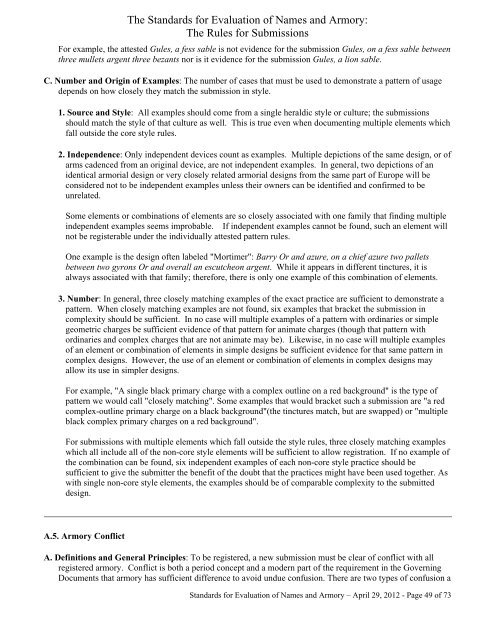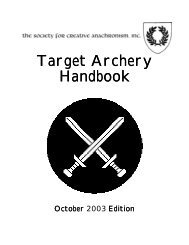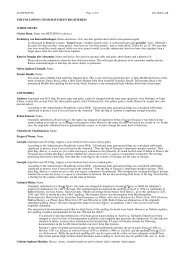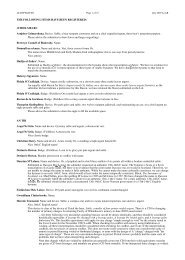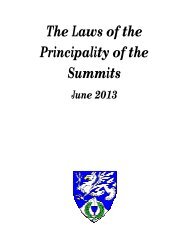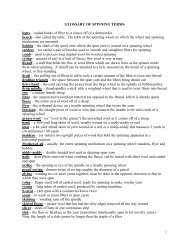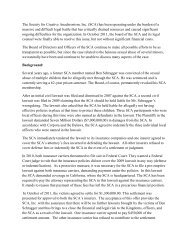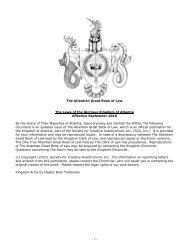<strong>The</strong> <strong>St<strong>and</strong>ards</strong> <strong>for</strong> <strong>Evaluation</strong> <strong>of</strong> <strong>Names</strong> <strong>and</strong> <strong>Armory</strong>:<strong>The</strong> Rules <strong>for</strong> SubmissionsFor example, the attested Gules, a fess sable is not evidence <strong>for</strong> the submission Gules, on a fess sable betweenthree mullets argent three bezants nor is it evidence <strong>for</strong> the submission Gules, a lion sable.C. Number <strong>and</strong> Origin <strong>of</strong> Examples: <strong>The</strong> number <strong>of</strong> cases that must be used to demonstrate a pattern <strong>of</strong> usagedepends on how closely they match the submission in style.1. Source <strong>and</strong> Style: All examples should come from a single heraldic style or culture; the submissionsshould match the style <strong>of</strong> that culture as well. This is true even when documenting multiple elements whichfall outside the core style rules.2. Independence: Only independent devices count as examples. Multiple depictions <strong>of</strong> the same design, or <strong>of</strong>arms cadenced from an original device, are not independent examples. In general, two depictions <strong>of</strong> anidentical armorial design or very closely related armorial designs from the same part <strong>of</strong> Europe will beconsidered not to be independent examples unless their owners can be identified <strong>and</strong> confirmed to beunrelated.Some elements or combinations <strong>of</strong> elements are so closely associated with one family that finding multipleindependent examples seems improbable. If independent examples cannot be found, such an element willnot be registerable under the individually attested pattern rules.One example is the design <strong>of</strong>ten labeled "Mortimer": Barry Or <strong>and</strong> azure, on a chief azure two palletsbetween two gyrons Or <strong>and</strong> overall an escutcheon argent. While it appears in different tinctures, it isalways associated with that family; there<strong>for</strong>e, there is only one example <strong>of</strong> this combination <strong>of</strong> elements.3. Number: In general, three closely matching examples <strong>of</strong> the exact practice are sufficient to demonstrate apattern. When closely matching examples are not found, six examples that bracket the submission incomplexity should be sufficient. In no case will multiple examples <strong>of</strong> a pattern with ordinaries or simplegeometric charges be sufficient evidence <strong>of</strong> that pattern <strong>for</strong> animate charges (though that pattern withordinaries <strong>and</strong> complex charges that are not animate may be). Likewise, in no case will multiple examples<strong>of</strong> an element or combination <strong>of</strong> elements in simple designs be sufficient evidence <strong>for</strong> that same pattern incomplex designs. However, the use <strong>of</strong> an element or combination <strong>of</strong> elements in complex designs mayallow its use in simpler designs.For example, "A single black primary charge with a complex outline on a red background" is the type <strong>of</strong>pattern we would call "closely matching". Some examples that would bracket such a submission are "a redcomplex-outline primary charge on a black background"(the tinctures match, but are swapped) or "multipleblack complex primary charges on a red background".For submissions with multiple elements which fall outside the style rules, three closely matching exampleswhich all include all <strong>of</strong> the non-core style elements will be sufficient to allow registration. If no example <strong>of</strong>the combination can be found, six independent examples <strong>of</strong> each non-core style practice should besufficient to give the submitter the benefit <strong>of</strong> the doubt that the practices might have been used together. Aswith single non-core style elements, the examples should be <strong>of</strong> comparable complexity to the submitteddesign.A.5. <strong>Armory</strong> ConflictA. Definitions <strong>and</strong> General Principles: To be registered, a new submission must be clear <strong>of</strong> conflict with allregistered armory. Conflict is both a period concept <strong>and</strong> a modern part <strong>of</strong> the requirement in the GoverningDocuments that armory has sufficient difference to avoid undue confusion. <strong>The</strong>re are two types <strong>of</strong> confusion a<strong>St<strong>and</strong>ards</strong> <strong>for</strong> <strong>Evaluation</strong> <strong>of</strong> <strong>Names</strong> <strong>and</strong> <strong>Armory</strong> – April 29, 2012 - Page 49 <strong>of</strong> 73
<strong>The</strong> <strong>St<strong>and</strong>ards</strong> <strong>for</strong> <strong>Evaluation</strong> <strong>of</strong> <strong>Names</strong> <strong>and</strong> <strong>Armory</strong>:<strong>The</strong> Rules <strong>for</strong> Submissionssubmission must avoid. <strong>The</strong> first is confusion <strong>of</strong> identity <strong>and</strong> is based on the ideas <strong>of</strong> visual similarity <strong>and</strong>heraldic equivalency. In this case, confusion is caused by the appearance <strong>of</strong> owning armory that is the sameas or has effectively no difference from registered armory which belongs to someone else. <strong>The</strong> second isconfusion <strong>of</strong> relationship <strong>and</strong> is based on the idea that children would use armory that was similar to butdifferenced or cadenced from that <strong>of</strong> their parents.<strong>The</strong> methods by which children would difference their arms from their parent's arms were sometimes knownas cadency steps, <strong>and</strong> the st<strong>and</strong>ards which developed <strong>for</strong> these differences are collectively called "cadency".Cadency in our period was a complex, changing set <strong>of</strong> guidelines that varied widely. <strong>The</strong>se rules are designedto treat as cadency steps most <strong>of</strong> the important period <strong>for</strong>ms <strong>of</strong> cadency while ignoring changes that were usedrarely, only in exceptional cases, or only during the early proliferation <strong>of</strong> heraldry.In general, we require two armorial designs to have a level <strong>of</strong> difference greater than a single cadency step, sothat they do not make the claim to be close relatives <strong>of</strong> each other or confuse their identities. This can beeither a single greater change, <strong>of</strong> types not generally used <strong>for</strong> cadencing, or two changes that are equivalent tocadency steps. Two designs which differ in one <strong>of</strong> these ways are said to be clear <strong>of</strong> conflict, or "independentdesigns". In some cases, two armorial designs, despite having sufficient technical differences, may haveoverwhelming visual similarity, causing undue confusion <strong>and</strong> thus these two designs will be considered to bein conflict.In general, we call changes which are equivalent to cadency steps "distinct changes", abbreviated as DC.Older rulings may refer to these types <strong>of</strong> changes as "significant differences", "clear differences", "CD"s, oreven "clear visual differences" <strong>and</strong> "CVD"s. <strong>The</strong>re are other types <strong>of</strong> changes which are greater than that,normally seen between "strangers in blood" rather than related individuals. We call these larger changessubstantial changes, abbreviated as SC. Older rulings regarding substantial changes may also refer to"substantial difference" or "X.2". <strong>The</strong>re are also changes which are smaller than a cadency step. <strong>The</strong>sechanges do not contribute to difference between two armorial designs, <strong>and</strong> are discussed in A.5.C.3 below.B. <strong>Armory</strong> Protected from Conflict: To be clear <strong>of</strong> conflict, a new submission must be clear <strong>of</strong> conflict with allregistered armory. A piece <strong>of</strong> armory is registered <strong>and</strong> protected from the moment it is listed as accepted on apublished Letter <strong>of</strong> Acceptances <strong>and</strong> Returns. Registered armory will be listed in the Ordinary <strong>and</strong> Armorialas soon as possible, but it is protected as soon as the Letter <strong>of</strong> Acceptances <strong>and</strong> Return is published. We alsoprotect armory <strong>of</strong> important people <strong>and</strong> entities outside the <strong>SCA</strong>; they are addressed in A.6 Presumptionbelow.C. Comparisons <strong>of</strong> <strong>Armory</strong>: When considering armory <strong>for</strong> purposes <strong>of</strong> possible conflict, there are a number <strong>of</strong>factors which should be considered. However, which piece <strong>of</strong> armory is the currently registered item is not afactor which needs to be considered.1. Blazons Which Must Be Considered: While we register the emblazon, rather than the blazon, mostconflict checking is done from the blazon. Thus, when considering armory <strong>for</strong> purposes <strong>of</strong> possibleconflict, all reasonable blazons <strong>for</strong> a specific design must be considered. You may not blazon your way out<strong>of</strong> conflict. Blazons that are unregisterable under our core style rules (such as blazons that would producequaternary charges or contrast issues) or that require unlikely underst<strong>and</strong>ings <strong>of</strong> an armorial design do notneed to be considered <strong>for</strong> conflict purposes, unless that blazon is due to the use <strong>of</strong> an Individually AttestedPattern, is due to voiding or fimbriation, or is the existing blazon <strong>of</strong> a piece <strong>of</strong> registered armory.For example, a lozenge throughout must also be considered as vêtu. Thus Vert, on a lozenge throughoutargent, a rose proper must be considered both under that blazon <strong>and</strong> as Argent vêtu vert, a rose proper. Forexample, three fesses must also be considered as barry. Thus, Gules, three fesses ermine must beconsidered both under that blazon <strong>and</strong> as Barry gules <strong>and</strong> ermine. This is true whenever armory uses threeor more identical ordinaries.<strong>St<strong>and</strong>ards</strong> <strong>for</strong> <strong>Evaluation</strong> <strong>of</strong> <strong>Names</strong> <strong>and</strong> <strong>Armory</strong> – April 29, 2012 - Page 50 <strong>of</strong> 73


